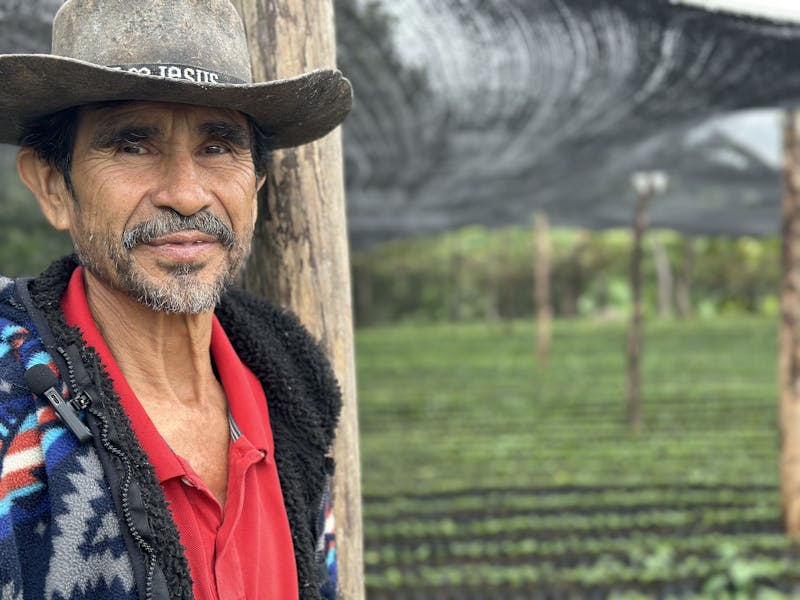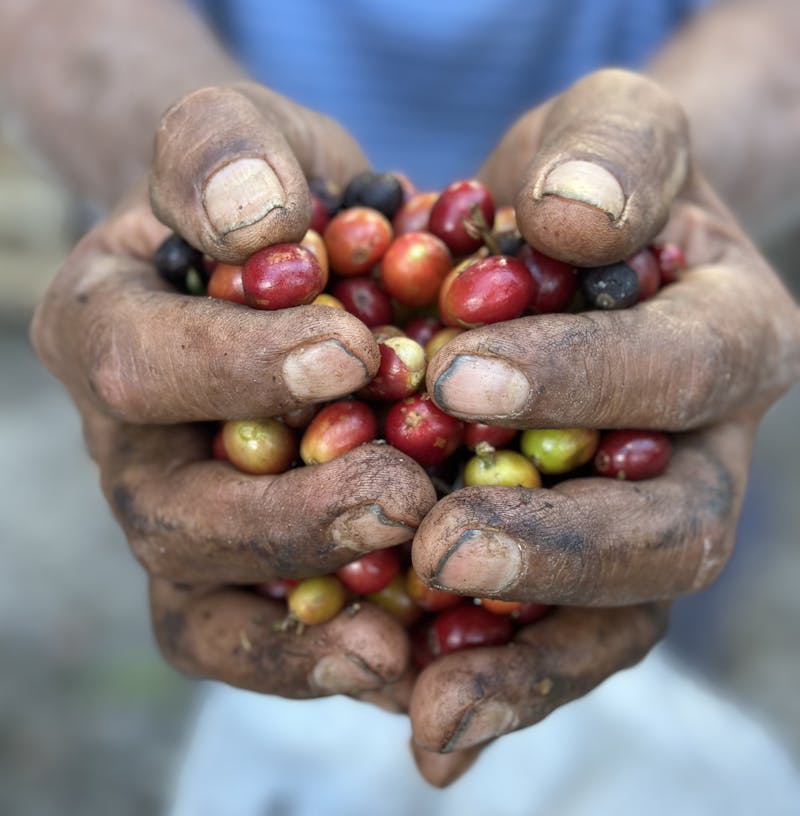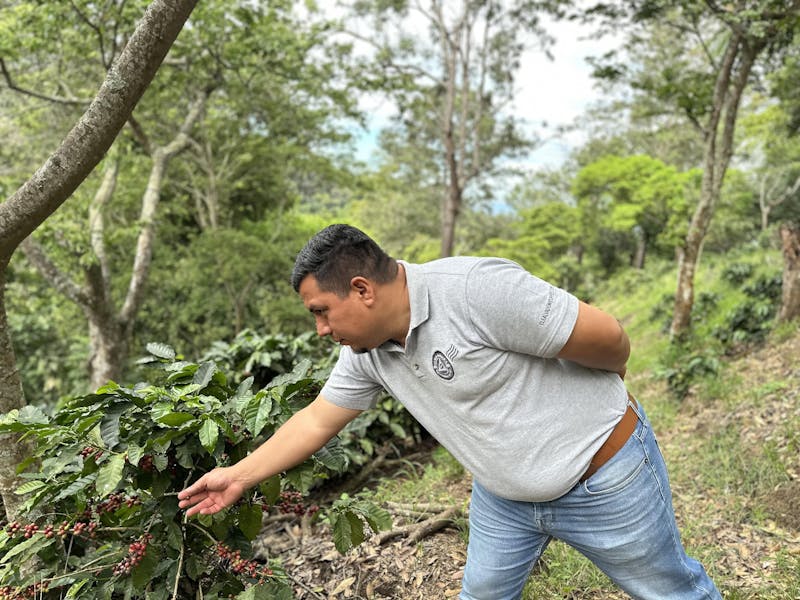SAN MARTIN JILOTEPEQUE, Guatemala — José Marcelino Estrada has spent his life tending coffee. He learned from his father how to nurture its seedlings — each sprout held the promise of a better future.
And for decades, coffee delivered.
It built Estrada’s home and put his seven children through school, even in lean years when he couldn’t pay for transportation and carried harvests to market on his back.
“Land is life. For me, earth is a treasure,” he said, standing among coffee trees on his southern Guatemala farm. “I want to leave something for those who come after me, so my children can continue to live off the land.”

José Marcelino Estrada, a small coffee farm owner in Guatemala, has worked to make his farm more climate resilient in hopes of passing it on to his children.
But climate change threatens to upend his livelihood and his legacy.
For generations, farmers in Guatemala’s coffee-growing highlands have relied on nature’s steady rhythms to guide their planting and harvesting. Now, rains that once arrived like clockwork are increasingly erratic. Temperatures are rising. And punishing dry spells are punctuated by torrential downpours, disrupting the delicate timing needed for coffee to flower and bear fruit.
Warmer, wetter conditions have also unleashed outbreaks of coffee leaf rust, a fungal disease that wiped out coffee farms across Central America a decade ago, causing more than US$ 3 billion in damages and leaving nearly 2 million coffee workers without a job.
In a quest to combat coffee rust (la roya in Spanish), a Starbucks 100 million trees initiative supported by Conservation International has delivered climate-resilient coffee seedlings to more than 40,000 farmers across Guatemala, Mexico and El Salvador — and is now nearing its goal of donating 100 million trees in those three countries. At the heart of this effort is the Marsellesa, a hardy arabica varietal developed by scientists in France and Nicaragua to withstand a warming climate.
Around the world, farmers are experimenting with new strategies to stay ahead of climate impacts, but few crops are as vulnerable to climate change as coffee. As growers rethink how — and even where — they cultivate their beans, the program is one in a series of innovations and adaptations aimed at blunting future climate threats.
“No one has a playbook for how to deal with climate change; farmers are just trying to stay one step ahead of it,” said Raina Lang, who leads Conservation International’s coffee program. “They’re trying different strategies — from planting climate-resilient varieties, to reintroducing traditional methods of controlling rain and soil erosion.”
In Central America, where coffee is deeply woven into the economy and cultural identity, the stakes are profound.

A coffee worker weighs and bags coffee beans. Production has dropped in recent years as warmer and wetter conditions reduce the areas suitable for growing arabica coffee.
Seeds of hope
For Estrada, there’s little choice but to persevere. While he and his brother inherited his father’s land, he wanted a farm of his own to pass on to his children.
Several years ago, he bought 10 hectares (25 acres) of cattle pasture in the hills outside his hometown. The land was little more than dust and grass. Some might have written it off as barren; Estrada saw potential.
He poured himself into restoring it, loosening the compacted soil, enriching it with compost and planting shade trees. The Starbucks program supplied nearly 34,000 Marsellesa trees over seven years, cutting Estrada’s planting costs in half and helping his farm get up and running.
-copy-2.jpg?sfvrsn=5900dec7_1&&auto=compress&auto=format&fit=crop?&auto=compress&auto=format&w=800)
A Guatemalan nursery grows Marsellesa trees, a climate-resilient arabica variety bred to resist the coffee rust fungus.
Now, neat rows of Marsellesa trees stretch across his farm’s gentle slopes, their branches studded with clusters of ripe, red coffee cherries. Native oak and cedars create a protective canopy alongside banana trees, which Estrada planted for food and extra income.
“Here is our future,” he said, surveying his work. “I know that with it, we will always put food on the table. That’s what it represents. It’s like an insurance policy."
It’s not just Estrada’s future that is at stake.
With more than 2 billion cups consumed daily, coffee is the world’s most traded agricultural commodity. In Central America alone, the sector directly employs more than 1.2 million people.
But by 2050, rising temperatures could shrink the global area suitable for growing coffee by half. And at least 60 percent of all coffee species — including arabica, the most popular bean — are at risk of going extinct in the wild due to climate change, deforestation and disease.
“We could see a big shift in where coffee is grown, which could affect everything from the way it tastes, to how much can be produced and what ecosystems will be impacted, to who benefits from it,” Lang said.
Coffee rust, which attacks older trees, exacerbates these impacts — the blight is both a symptom of climate change and a driver of future losses, increasing deforestation by forcing farmers to clear trees at higher altitudes to plant coffee.
“Planting new, climate-resilient trees like the Marsellesa helps farmers renovate their farms, which is one of the best ways to keep farms healthy and productive,” Lang added. “It also protects forests by helping farmers stay within their existing footprints rather than expanding into new areas.”
To qualify for the program, farmers must adhere to an ethical sourcing program developed by Starbucks and Conservation International to promote sustainable farming, fair wages and environmental protection. Upon deciding to enter the program, farmers agree not to plant donated coffee trees in forested areas, maintain existing native shade trees, and adopt practices that protect the soil and minimize erosion.
Each year, Lang travels to Central America to visit dozens of coffee farms of all sizes, ensuring that healthy seedlings have arrived, program safeguards are upheld and mature Marsellesa trees are thriving. She also listens to farmers' feedback on the program.
“Given the large-scale nature of this program, annual visits provide a moment of reflection to ensure it continues to fulfill its purpose,” she said. “Hearing from farmers on the challenges they are facing, and how these new seedlings are impacting production — and their families’ lives — not only helps us adjust the current program but informs future programs that support climate adaptation.”
A forest that grows coffee
At La Pastoria, a sprawling 633-hectare (1,564-acre) farm in southeastern Guatemala, operations manager Carlos Virula López guides Lang on a tour to check on the Marsellesa trees. La Pastoria received 200,000 hybrid seedlings last year — a game-changer that allowed the farm to replace old trees that were susceptible to coffee rust twice as quickly as planned.
Enroute to the coffee grove, Virula López winds through tidy fields of mango trees in a muscular 4x4 golf cart. Rooted in sunbaked soil, the trees are planted in precise rows like lines on a ruled page — an efficient and orderly monoculture.
By contrast, the terraced coffee grove feels alive. Fragrant cedar, sturdy oak and nitrogen-fixing Inga trees form a layered canopy, providing a wind break and the perfect amount of shade for coffee. Beneath their cover, the ground is soft and dark, blanketed with decomposing leaves that enrich the soil with nutrients.
This shaded microclimate sustains more than just coffee. Virula López estimates the farm is home to about 80 species, including armadillos, agoutis, deer, toucans, owls and hawks. Workers keep a log, noting every new sighting.

Carlos Virula López, operations manager at a coffee farm in Guatemala, was able to replace old trees that were susceptible to coffee rust with Marsellesa trees thanks to Starbucks' 100 million trees initiative.
“This is not a plantation, it’s a forest that produces coffee,” he said. “It contributes to the environment and to reducing the carbon footprint. What we want here on the farm is to protect our natural resources."
Even with the infusion of new trees provided by the Starbucks 100 million trees initiative, keeping farms running requires a daily commitment, Virula López said.
Despite record coffee prices on the global market, large farms like this one — and the forests they sustain — are being sold off as climate change and a persistent labor shortage make it increasingly difficult to keep them running. Their lands are being carved up into housing lots or divided into smaller parcels for hardier crops better suited to the changing conditions.
“Some people no longer want to continue, because they believe it doesn’t give them what they want — profitability,” Virula López said. For ecosystems like this one to endure, “you have to truly care about the coffee. You have to love it, in the good times and the bad.”
“Maintaining the environment, the flora and fauna, is not just for my generation,” he added. “It’s for the generations to come.”
Old ways, new tools
In lush, coffee-growing regions of Central America, when yields fall or prices fluctuate, entire communities feel the effects. In El Salvador, coffee used to drive the economy, making up 40 percent of export earnings in the 1990s. But over the past two decades, production has dropped by more than half.
“When there is no production, there is no money to work the fields,” said José Contreras, an agronomist with the Salvadoran coffee export firm UNEX. “It’s not the same to have 20 people employed year-round as it is to have those same people employed only half the year — workers’ earnings are directly affected. And it’s hard for producers to pay for renovating farms on their own. That’s why programs like the one with Starbucks are so important.
“All the plots, as long as they’re well-maintained, respond well. So this directly impacts production.”
At the Aguas Calientes farm, tucked into the lush hills of central El Salvador, manager Danilo Jiménez said last year brought the biggest changes yet in weather patterns. After months of drought, heavy rains carved gullies into his coffee terraces, eroding soil and threatening to uproot trees. Jiménez turned to a local elder for advice.
“‘Look,’ he told me, ‘why don’t you dig pits in the ground, in a zigzag pattern down the hill? It will catch the water and keep the soil from washing away,’” Jiménez recalled.

In a quest to adapt to climate change, Salvadoran farm manager Danilo Jiménez has turned to new and old techniques.
Jiménez followed the advice. He invested in digging the pits and added native Izote trees with deep taproots to stabilize the soil. The results were undeniable: less erosion, healthier trees and a more resilient farm.
For Jiménez, climate adaptation means blending ancient methods with modern innovations, like the Marsellesa hybrids now bearing fruit in Aguas Calientes’ fields.
“I would be lying if I said there’s an exact formula for what to do — there isn’t,” he said. “We’re just trying to adapt to what we’re living, day by day.”
As climate change reshapes coffee-growing landscapes across the globe, Jiménez says it’s this fusion of tradition and science that may offer the best chance for survival — and success.
“There has to be a balance, a symbiosis, between the old and the new,” he said. “That’s what we’re doing — using old cultivation practices with new varieties. Both approaches go hand in hand. It’s not just one or the other; there has to be a combination of the two.”
Vanessa Bauzá is the senior communications director at Conservation International. Want to read more stories like this? Sign up for email updates. Also, please consider supporting our critical work.